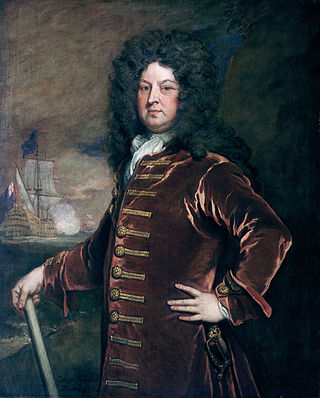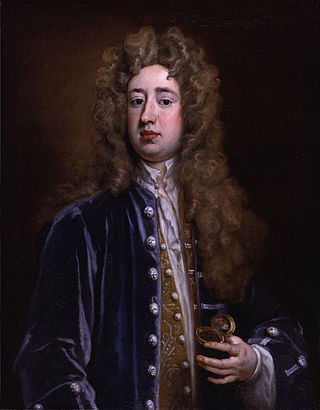Related Research Articles

General John Churchill, 1st Duke of Marlborough, 1st Prince of Mindelheim, 1st Count of Nellenburg, Prince of the Holy Roman Empire, was an English soldier and statesman. From a gentry family, he served as a page at the court of the House of Stuart under James, Duke of York, through the 1670s and early 1680s, earning military and political advancement through his courage and diplomatic skill. He is known for never having lost a battle.

Lieutenant-General Thomas Tollemache was an English Army officer and politician. Beginning his military career in 1673, in 1686 he resigned his commission in protest at the commissioning of Catholic officers into the Army by James II of England. A supporter of military intervention by the Protestant William of Orange against James II, in early 1688 he joined a regiment of the Anglo-Scots Brigade, a mercenary unit in the Dutch States Army.

Henry Ireton was an English general in the Parliamentarian army during the Wars of the Three Kingdoms, and the son-in-law of Oliver Cromwell. He died of disease outside Limerick in November 1651.

James FitzJames, 1st Duke of Berwick, 1st Duke of Liria and Jérica, 1st Duke of Fitz-James was an Anglo-French military leader and the illegitimate son of King James II and VII by Arabella Churchill, sister of the 1st Duke of Marlborough. Berwick was a successful general in the pay of Louis XIV of France.

Field Marshal George Hamilton, 1st Earl of Orkney,, styled Lord George Hamilton from 1666 to 1696, was a British soldier and Scottish nobleman and the first British Army officer to be promoted to the rank of field marshal. After commanding a regiment for the cause of William of Orange during the Williamite War in Ireland, he commanded a regiment in the Low Countries during the Nine Years' War. He then led the final assault at the Battle of Blenheim attacking the village churchyard with eight battalions of men and then receiving the surrender of its French defenders during the War of the Spanish Succession. He also led the charge of fifteen infantry battalions in an extremely bloody assault on the French entrenchments at the Battle of Malplaquet. In later life, he became a Lord of the Bedchamber to George I and was installed as Governor of Edinburgh Castle.

Lieutenant-General William Cadogan, 1st Earl Cadogan was an Irish-born British Army officer. He began his active military service during the Williamite War in Ireland in 1689 and ended it with the suppression of the 1715 Jacobite Rebellion. A close associate and confidant of the Duke of Marlborough, he was also a diplomat and Whig politician who sat in the English and British Houses of Commons from 1705 until 1716, when he was raised to the peerage as Baron Cadogan.

Sir Hardress Waller was born in Kent and settled in Ireland during the 1630s. A first cousin of Parliamentarian general William Waller, he fought for Parliament in the Wars of the Three Kingdoms, becoming a leading member of the radical element within the New Model Army. In 1649, he signed the death warrant for the Execution of Charles I, and after the Stuart Restoration in 1660 was condemned to death as a regicide.

Richard Talbot, 1st Earl of Tyrconnell, was an Irish politician, courtier and soldier.

Carton House is a country house and surrounding demesne that was the ancestral seat of the Earls of Kildare and Dukes of Leinster for over 700 years. Located 23 km west of Dublin, in Maynooth, County Kildare, the Carton Demesne is a 1,100 acres estate, from an original estate of 70,000 acres. For two hundred years, the Carton Demesne was the finest example in Ireland of a Georgian-created parkland landscape. In the 2000s, much of the demesne was redeveloped into two golf courses and the house into a hotel complex.
Colonel Sir Richard Ingoldsby was an English officer in the New Model Army during the English Civil War and a politician who sat in the House of Commons variously between 1647 and 1685. As a Commissioner (Judge) at the trial of King Charles I, he signed the king's death warrant but was one of the few regicides to be pardoned.

Admiral of the Blue George Churchill was an English naval officer, who served as a Lord Commissioner of the Admiralty from 1699 to 1702 and sat on the Lord High Admirals Council from 1702 to 1708. He was Member of Parliament for St Albans from 1685 to 1708, then Portsmouth from 1708 until his death in 1710.

Major General Charles Trelawny, also spelt 'Trelawney', was an English soldier from Cornwall who played a prominent part in the 1688 Glorious Revolution, and was a Member of Parliament for various seats between 1685 and 1713.

General Joseph Sabine was a British Army officer who fought in the Nine Years' War, the War of Spanish Succession and the Jacobite rising of 1715. He was later a politician who sat in the House of Commons from 1727 to 1734, becoming Governor of Gibraltar in 1730.

General Charles Churchill was a British Army officer who served during the War of the Spanish Succession and an English politician who sat in the English and British House of Commons from 1701 to 1710. He was a younger brother of John Churchill, 1st Duke of Marlborough and both his military and political careers were closely connected with his brother's. Along with Marlborough's Irish Chief of Staff William Cadogan, he was one of Churchill's closest advisors. He was a Tory, in contrast to his Whig brother who tolerated and possibly used Churchill's Tory connections.
Sir Henry Ingoldsby, 1st Baronet (1622–1701) was an English military commander and landowner.
General Sir Philip Honywood KB was a British Army officer.
Sir Richard Ingoldsby, KB, of Lethenborough, Buckinghamshire, was the son of Sir Richard Ingoldsby of Lethenborough, the High Sheriff of Buckinghamshire in 1606, and of his first wife Elizabeth Palmer. She was the daughter of William Palmer, of Waddesdon, Buckingamshire and Joyce Pigott,.

Lieutenant-General George Macartney or MacCartney was an Irish-born professional soldier who went into exile to escape charges for his role in the 1712 Hamilton–Mohun Duel. He was later acquitted and restored to his military rank.

Henry Withers was a British army officer and politician, who began his career in 1674 during the Franco-Dutch War and reached the rank of Lieutenant General in 1707. A close associate of the Duke of Marlborough during the War of the Spanish Succession, he served in a number of actions, including the 1704 battles of Schellenberg, Blenheim, and Malplaquet in 1709.